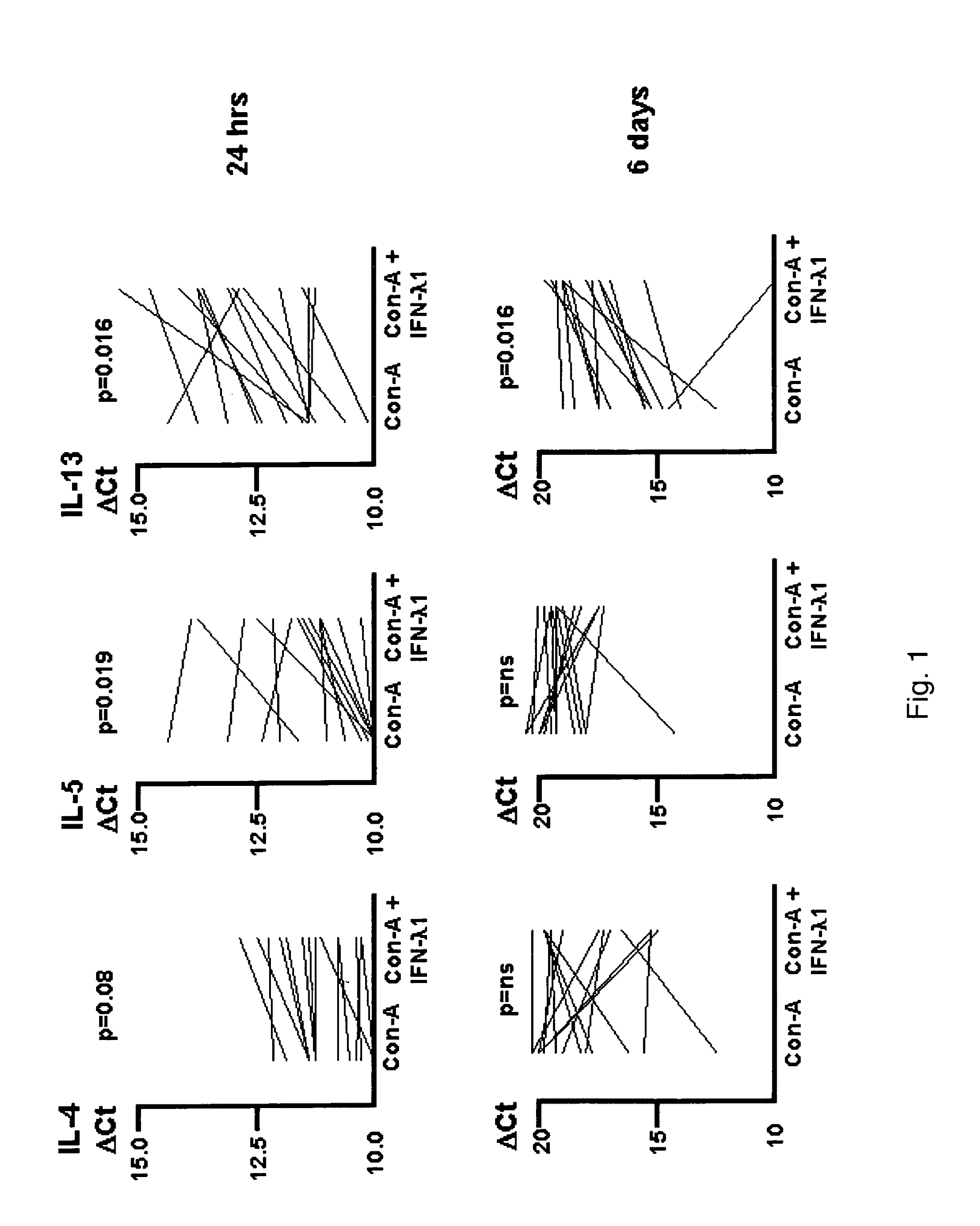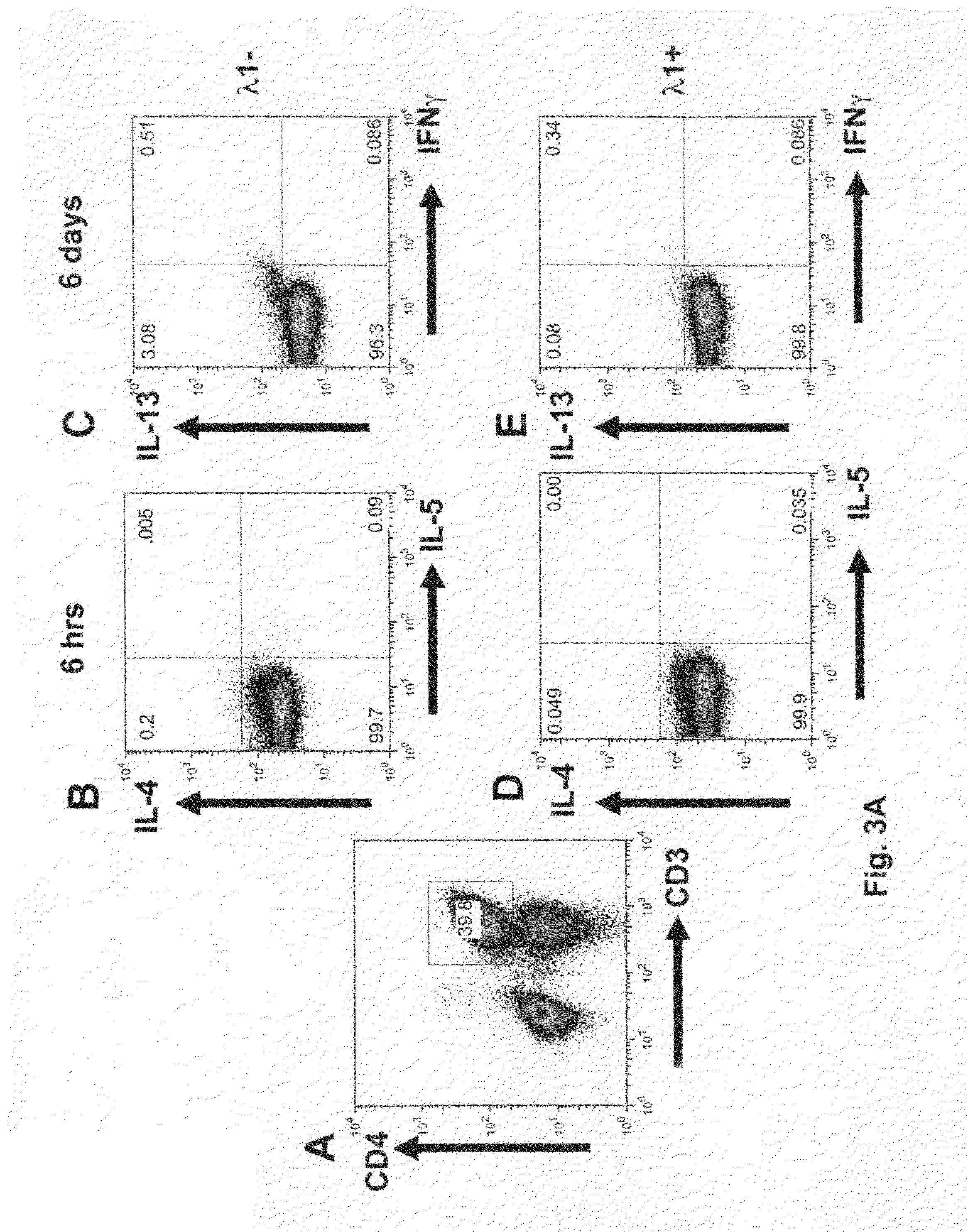Ex-vivo treatment of peripheral blood leukocytes with IFN-lambda
a technology of peripheral blood leukocytes and ex vivo treatment, which is applied in the direction of biocide, drug composition, peptide/protein ingredients, etc., can solve the problems of significant mortality and morbidity, presently no cure for ibd, and surgery cannot guarantee successful treatment, so as to achieve the effect of reducing the progression
- Summary
- Abstract
- Description
- Claims
- Application Information
AI Technical Summary
Benefits of technology
Problems solved by technology
Method used
Image
Examples
example 1
Stimulation of Peripheral Blood Mononuclear Cells Causes Specific Cytokine Transcription: IFN-λ Lowers the mRNA Levels for IL-4 and IL-13
[0162]Human peripheral blood was obtained by venipuncture. Peripheral blood mononuclear cells (PBMC) were isolated using Ficoll-Hypaque gradient. PBMC were stimulated in vitro with Con-A, in the presence or absence of 100 ng / ml IFN-λ1 for 24 hours or 6 days. Then, 2×106 PBMC were incubated in 2 ml volume in 24-well plates. Total RNA was harvested and subjected to reverse transcription. The resulting cDNA was tested for the level of expression of IL-4, IL-5 and IL-13. EF-1a was used as the reference cDNA against which the Ct for the cytokine genes was established. Samples were run in triplicate. These ΔCts are plotted in FIG. 1. Results shown non-dotted lines were the ΔCts that were higher in the presence of IFN-λ1 (indicating less cytokine signal was present). Results were compared by the Wilcoxon test for non-parametrically distributed paired data...
example 2
[0163]Stimulation of Peripheral Blood Mononuclear Cells Causes Specific Cytokine Release: IFN-λ Lowers Secretion of IL-4, IL-5 and IL-13, but not IFN-γ
[0164]Supernatant fluid was harvested from the cultures described in Example 1 and tested for cytokine levels by ELISA (eBiosciences). Samples were run in triplicate. IFN-λ1, was observed to reduce cytokine secretion for IL-4 at 24 hours (14 / 14 donors, p=0.001), and IL-5 (13 / 14 donors, p=0.016) and IL-13 at 6 days (14 / 14 donors, p=0.001). Over all 14 donors, the level of IL-4, 1L-5 and IL-13 were reduced by IFN-λ by 0.33×[0.25-0.38], 0.42×[0.27-0.49] and 0.22×[0.18-0.32], respectively. IFN-γ levels were not affected by IFN-λ1. The results of the study are shown in FIG. 2.
example 3
IFN-λ Reduces the Number of IL-4, -5, -13 and IFN-γ Positive Cells CD4 T-Cells
[0165]FACS was used to evaluate the effects of IFN-λ1 on number of IL-4, IL-5, IL-13 and IFN-γ cells. As in Example 1, cells were incubated with IFN-λ1 for 6 hours or 6 days, with no re-stimulation. Cells were gated on the CD4+ population and examined by FACS for positivity with intracellular IL-4, IL-5, IL-13 and IFN-γ. Antibodies were from eBiosciences or BD BioSciences. Although the numbers of stained cells were low, IFN-λ1 reproducibly diminished the number of IL-4+ CD4+ T-cells (by 75%, 56% and 46%, donors A-C) at 6 hours and of IL-13+ CD4 T-cells (by 84%, 54%, 48%, 75%, 49% and 42%, donors A-E (See FIG. 3)). IFN-γ+ CD4+ T-cells were not altered by IFN-λ1. Notwithstanding the presence of IFN-γ+ T-cells and the presence of IFN-γ− in the supernatant, cells progressed through to a population of IL-13+, IFN-γ− cells (See FIG. 3B). In addition, we observed that IFN-λ is effective at decreasing the number o...
PUM
| Property | Measurement | Unit |
|---|---|---|
| concentration | aaaaa | aaaaa |
| concentration | aaaaa | aaaaa |
| temperatures | aaaaa | aaaaa |
Abstract
Description
Claims
Application Information
 Login to View More
Login to View More - R&D
- Intellectual Property
- Life Sciences
- Materials
- Tech Scout
- Unparalleled Data Quality
- Higher Quality Content
- 60% Fewer Hallucinations
Browse by: Latest US Patents, China's latest patents, Technical Efficacy Thesaurus, Application Domain, Technology Topic, Popular Technical Reports.
© 2025 PatSnap. All rights reserved.Legal|Privacy policy|Modern Slavery Act Transparency Statement|Sitemap|About US| Contact US: help@patsnap.com



